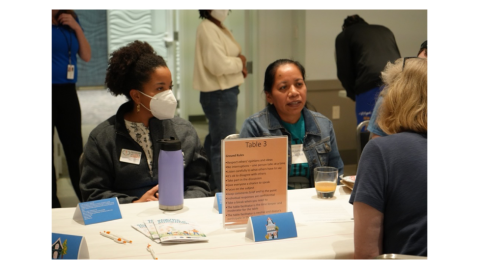In recent years, many informal science education institutions have worked to employ co-creation as a strategy for including and sustaining community priorities and perspectives throughout Public Engagement with Science (PES) activities, with a particular emphasis on responding to the “problems that communities view as worth solving”; that is, asking communities what issues they would like to see us as ISE institutions address in our programming and working with civic and community partners to address these topics. As the culminating phase of the NSF-funded Building Capacity For Co-Created Public Engagement with Science these partners from around the country will adapt the co-creation model from the project and work with civic and community partners to create and host Public Engagement with Science activities together this spring. We congratulate these NISE Network partner stipend recipients and look forward to their work!
- Bisbee Science and Exploration Center, Bisbee, AZ
- Da Vinci Science Center, Allentown, PA
- Explora, Albuquerque, NM
- Great Lakes Science Center, Cleveland, OH
- McWane Science Center, Birmingham, AL
- Orlando Science Center, Orlando, FL
- Memphis Museum of Science and History, Memphis, TN
- Sciencenter, Ithaca, NY
- The Works: Ohio Center for History, Art & Technology, Newark, OH

Co-Creation Background

In the informal science education (ISE) field, we use the term “public engagement with science” (PES) to refer to many of the things we do every day. But science museums and other ISE institutions are increasingly using the term when facilitating opportunities for community members to consider topics that lie at the intersection of science and society with one another and to share their perspectives and ideas with scientific and civic institutions to inform decision-making. As part of the NSF-funded project Multi-Site Public Engagement with Science – Synthetic Biology (NISE Net partners may recognize this as the project that created the Building with Biology materials), the Museum of Science (MOS) wrote Public Engagement with Science: A guide to creating conversations among publics and scientists for mutual learning and societal decision-making, describing Public Engagement with Science (PES) as “…conversations between scientists and members of the public where both groups learn from each other about developments in science and their applications to society. This includes: the problems that communities view as worth solving; the information society needs and wants from scientists; the potential risks, benefits, and consequences of new technologies; building and sustaining trust among stakeholders; and finding common ground and working towards shared decisions about science-related controversies.” This guide, along with many of the resources we have created to facilitate conversations about socio-scientific questions, can be found on our MOS website at http://publicengagementwithscience.org/.
In recent years, we have worked to employ co-creation as a strategy for including and sustaining community priorities and perspectives throughout PES activities, with a particular emphasis on responding to the “problems that communities view as worth solving”; that is, asking communities what issues they would like to see us as ISE institutions address in our programming and working with civic and community partners to address these topics. In The Participatory Museum, Nina Simon writes, “In co-creative projects, community members work together with institutional staff members from the beginning to define the project’s goals and to generate the program or exhibit based on community interests.”
NSF-funded Building Capacity For Co-Created Public Engagement with Science Project
As part of our NSF-funded Building Capacity For Co-Created Public Engagement with Science project (DRL-1811118), the Museum of Science, Boston, the Oregon Museum of Science and Industry (OMSI), and the Museum of Life and Science (MLS) in Durham, North Carolina have each worked over a period of years with community partners and local government to identify topics that community partners identify as relevant, facilitate conversations about these topics, and share the outcomes to inform decision-making and spark action. In Portland, Oregon, educators at OMSI worked with a local youth-led environmental justice organization called Momentum Alliance and the Oregon Metro Regional Government to engage youth from the three institutions in conversations about corporate responsibility and climate change. In Boston, MOS educators worked with students from the Urban College of Boston, the Mayor’s Office of New Urban Mechanics, and the Mayor’s Housing Innovation Lab to engage public participants in considering and making recommendations about locally relevant affordable housing and space issues. And MLS educators in Durham worked with partners from Families Moving Forward, an organization that serves families who are experiencing homelessness, and the City of Durham’s Neighborhood Improvement Services to take on issues pertaining to affordable housing access.
The educators at these science centers each worked closely with their partners to develop, evaluate, and revise socio-scientific questions for engagement with diverse audiences. Then, the teams crafted and revise their PES materials together, recruited participants, and held their PES events. Finally, the teams analyzed and discuss the participants' ideas, formulated action plans, and disseminated outcomes to facilitate action. In each of these phases, which we named the “agenda-setting”, “decision-making”, and policy-forming”phases based upon work from the policy and public engagement literature, teams of ISE educators, community partners, and civic planners worked together to create PES activities and evaluate them together to produce learning for our fields. While the project was deeply impacted by the pandemic, we have learned a lot of important lessons about co-creation and are now working to share these learning points with our field.
In this culminating phase of the project, we have selected nine fantastic ISE partners from around the country who will adapt the co-creation model from our project and work with civic and community partners to create and host PES activities together this spring. We will be sure to share the progress in their co-creation activities as their important work progresses.
